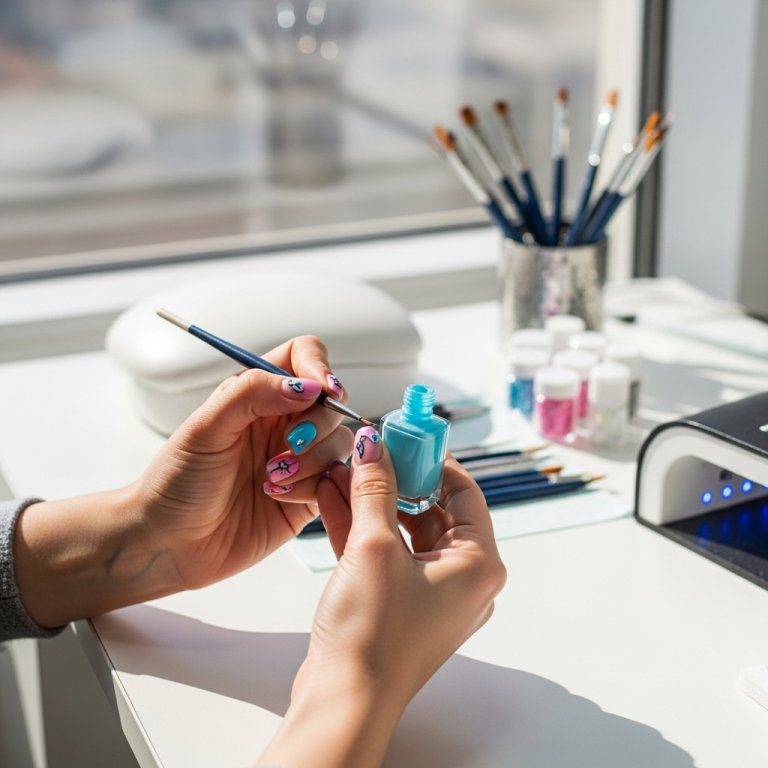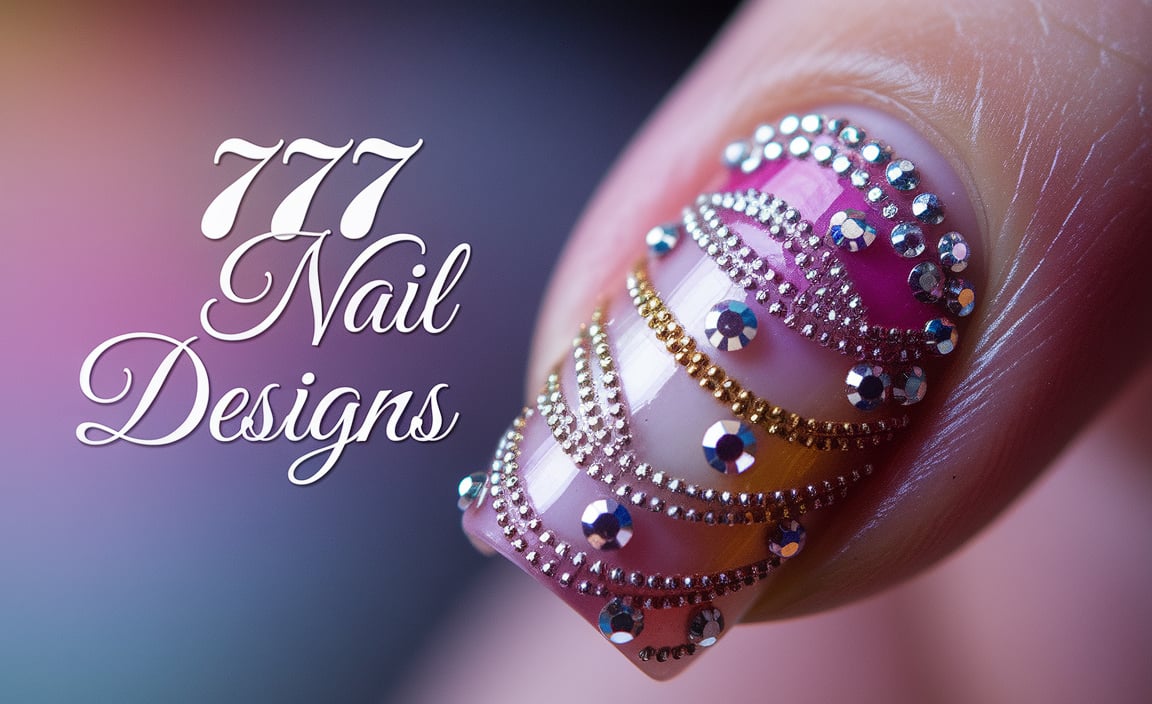Unlock stunning nail art at home! This guide shows you how to find and follow easy YouTube nail design tutorials for beginners, transforming your nails with simple steps, essential tools, and creative inspiration. Get ready for salon-worthy manicures without the salon price tag!
Dreaming of beautiful, trendy nails but feel completely lost about where to start? You’re not alone! Many of us scroll through Instagram or Pinterest, admiring intricate nail designs, and think, “There’s no way I can do that.” It’s easy to feel overwhelmed by the variety of polishes, tools, and techniques. But what if I told you that unlocking your inner nail artist is easier than you think? YouTube is your secret weapon, packed with thousands of free, step-by-step tutorials specifically for beginners. Let’s dive in and discover how to find the perfect video to help you create gorgeous nails right from your couch. Get ready to impress yourself and everyone else with your newfound nail design skills!
Why YouTube is Your Best Friend for Nail Art
When it comes to learning something new, especially a visual art like nail design, no platform beats YouTube. Think of it as your personal, on-demand nail school. You can pause, rewind, and rewatch as many times as you need. Unlike static images or articles, YouTube videos let you see exactly how each step is performed, from holding the brush to the final top coat. This makes it incredibly easy for anyone, no matter their current skill level, to pick up new techniques and create beautiful results. Plus, the sheer volume of content means there’s a design for every taste and occasion!
Finding the Perfect YouTube Nail Design Tutorial for Beginners
The first step to nailing your DIY manicure is finding the right tutorial. With so many videos out there, knowing where to start can feel like a challenge. But don’t worry, I’ve got a simple strategy for you!
Mastering Your Search Terms
The magic happens in the search bar! To find exactly what you’re looking for, use specific keywords. Instead of just searching for “nail designs,” try these more targeted phrases:
- “Easy nail designs for beginners”
- “Simple DIY nail art tutorials”
- “Beginner friendly nail tutorials no special tools”
- “Quick and easy nail art for short nails”
- “Step-by-step nail art for absolute beginners”
Adding terms like “step-by-step,” “easy,” or “beginner” will help filter out advanced content and bring you to the tutorials that are designed for you.
What to Look for in a Good Beginner Tutorial
Not all tutorials are created equal. Here’s what to keep an eye out for when choosing your first video:
- Clear Visuals: Can you clearly see the person’s hands and the nail art process? Good lighting and a steady camera are key.
- Slow Pace: The tutorial should move at a comfortable speed. The creator should explain each step thoroughly without rushing.
- Simple Designs: Look for designs that use basic techniques like dots, stripes, simple flowers, or glitter.
- Common Tools: Ideally, the tutorial should use tools you likely already have or can easily get, like toothpicks, bobby pins, or basic nail art brushes.
- Friendly Instructor: Does the person seem approachable and encouraging? A supportive tone can make all the difference!
- Viewer Comments: Scroll down to the comments section. See what other beginners are saying about the tutorial. Did they find it easy to follow? Did they achieve good results?
Essential Tools for Beginner Nail Art
You don’t need a whole nail tech kit to start creating beautiful designs. Many simple tutorials can be done with items you probably already have in your home! However, having a few key beginner-friendly tools can vastly expand your creative possibilities.
Must-Have Basics: Foundational Supplies
Before you even think about designs, make sure you have these foundational items:
- Nail Polish Remover: For correcting mistakes and starting with a clean slate.
- Cotton Balls/Pads: To apply the remover.
- Nail File: To shape your nails.
- Nail Buffer: To smooth the nail surface. This is super important for a polished look!
- Base Coat: Protects your natural nail and helps polish adhere better.
- Top Coat: Seals your design, adds shine, and makes your manicure last longer.
Beginner Nail Art Tools to Get You Started
Once you’re ready to add some flair, consider investing in a few inexpensive tools. These will make creating patterns so much easier!
Here’s a breakdown of some fantastic beginner tools:
| Tool | Description & How to Use | Why it’s Great for Beginners |
|---|---|---|
| Dotting Tools | These have metal balls of varying sizes at the tip. Dip the ball in polish and create dots, small flowers, or swirls. | Super easy to create uniform dots for countless patterns. Even a few dots can elevate a simple polish color. |
| Fine-Tipped Nail Art Brushes | These brushes have very fine bristles, perfect for drawing thin lines, tiny details, or filling in small areas. | Allows for precision. You can create delicate lines for French tips, simple stripes, or add outlines to shapes. Brands like Makartt offer affordable sets with a range of sizes. |
| Toothpicks | A classic DIY tool! The sharp tip can be used to create tiny dots, drag polish into simple patterns, or clean up edges. | Extremely accessible and cost-effective. Great for practicing dotting techniques before investing in dotting tools. |
| Thin Striping Tape | Adhesive tape that comes in rolls. Apply it to your dried polish, paint over it, and peel it off to reveal clean lines. | Perfect for creating crisp geometric designs, stripes, or dividing sections for color blocking. |
| Dotting Tool Alternative (Bobby Pins) | The rounded end of a bobby pin can be dipped in polish to create dots, similar to dotting tools. | A readily available household item that works surprisingly well for practicing dot designs. |
These tools are readily available online or at most beauty supply stores. For instance, looking at options on sites like Ulta can give you a good idea of what’s out there. Remember, you don’t need them all! Start with what feels manageable.
Step-by-Step: Following a YouTube Nail Design Tutorial
Now, let’s get into the fun part: actually creating the nail art! Following a tutorial is like following a recipe. Here’s how to make it smooth sailing:
Preparation is Key
Before you even click play, get your station ready. This will prevent interruptions and make the process much more enjoyable.
- Gather Your Supplies: Have all the polishes, tools, and removers mentioned in the tutorial laid out and easily accessible.
- Prep Your Nails: Make sure your nails are clean, filed to your desired shape, and buffed smooth. Apply your base coat and let it dry completely. A good base coat is crucial for nail health and polish longevity. Organizations like the American Academy of Dermatology offer great advice on general nail care.
- Prepare Your Workspace: Protect your surface with old newspapers or a tray. Have your base and top coats open and ready to go, if not already on your nails.
- Watch the Tutorial Once (Optional but Recommended): Briefly watch the entire tutorial from start to finish without pausing. This gives you an overview of the steps and helps you visualize the end result.
Executing the Design: Slow and Steady Wins the Race
This is where you’ll be actively following along with the video. Remember to be patient with yourself!
- Pause Frequently: Don’t try to keep up with the creator in real-time. Pause the video after each distinct step or instruction.
- Mimic the Movements: Watch closely how the creator holds their hands, their brush, or their dotting tool. Try to replicate their technique.
- Take Your Time: If a step involves drawing lines or dots, don’t rush. Steady your hand, take a breath, and do your best. It’s okay if your first attempt isn’t perfect!
- Don’t Be Afraid of Mistakes: Polish remover and a clean-up brush (or even a Q-tip dipped in remover) are your best friends. Forgive yourself for slips and clean them up as you go. Nobody’s nails are perfect on the first try!
- Apply Polish Thinly: Generally, it’s better to apply thin coats of polish than thick ones. Thin coats dry faster and are less prone to smudging.
- Allow for Drying Time: Make sure each layer of polish or design element is adequately dry before moving to the next step. This is crucial to prevent smudging and transferring. A quick-dry top coat can be a lifesaver here.
Finishing Touches: Sealing the Deal
You’re almost done! This last step ensures your beautiful design lasts.
- Apply Top Coat: Once your design is completely dry, apply a generous layer of top coat. This will seal in your art, add a beautiful shine, and protect it from chipping.
- Clean Up Edges: Use a small brush dipped in nail polish remover to clean up any polish on your skin around your nails for a super neat finish.
- Let it Cure: Give your top coat plenty of time to dry and harden. Avoid doing anything strenuous with your hands for at least an hour if possible.
Popular Beginner-Friendly Nail Designs to Try First
Ready to pick your first design? Here are some of the easiest and most popular nail art trends that beginner-friendly YouTube tutorials often feature. They look impressive but are surprisingly simple to execute!
1. The Classic Dot Manicure
What it is: Simple, uniform dots of polish in chosen colors, either all over the nail or in a pattern.
Tools needed: Dotting tools (various sizes recommended) or toothpicks/bobby pins.
Why it’s easy: Requires just dipping and placing. You can arrange dots in lines to make simple shapes like flowers or hearts, or just scatter them for a playful look.
2. Easy Striped Nails
What it is: Clean, graphic lines drawn across the nail.
Tools needed: Fine-tipped nail art brush, or thin striping tape.
Why it’s easy: With a steady hand and a fine brush, you can create simple vertical, horizontal, or diagonal stripes. Using striping tape is even easier – lay it down, paint over, peel off for instant perfection.
3. Glitter Gradient (Ombre) Nails
What it is: A transition from a solid color at the cuticle to a sparkling glitter at the tip, or vice versa.
Tools needed: A glitter polish and a regular polish color.
Why it’s easy: Simply apply the base color, let it dry, then dab glitter polish starting at the tip and blending downwards. It’s forgiving and looks chic!
4. Simple ‘Stamping’ with Household Items
What it is: Creating small, repeating patterns using readily available items.
Tools needed: Bobby pins, toothpicks, hairpins.
Why it’s easy: Dip the end of a bobby pin or toothpick into polish and press gently onto the nail. You can create small flowers, swirls, or even abstract shapes. This is a great way to experiment with pattern before committing to stamping plates.
5. The Minimalist Accent Nail
What it is: Keeping most nails a solid color and adding a simple design to just one or two nails.
Tools needed: Depends on the design for the accent nail – can be a dotting tool, fine brush, or even a small sticker.
Why it’s easy: You only have to focus your creativity on a small area, making it less intimidating. A single dot, a tiny stripe, or a little heart on an otherwise plain nail can make a big impact.
Tips for Maintaining Your DIY Nail Art
You’ve put in the effort, and your nails look amazing! Here’s how to make your hard work last:
- Always Use a Top Coat: This cannot be stressed enough! A good quality top coat is your best defense against chips and fading. Reapply it every 2-3 days for extra protection and shine.
- Be Gentle: Avoid using your nails as tools to pry open things, scrape stickers, or anything that could cause them to chip or bend.
- Moisturize: Keep your cuticles and hands hydrated. Dry skin can make even the most perfect manicure look less polished. Use cuticle oil regularly.
- Wear Gloves: When doing household chores involving water or harsh chemicals (like washing dishes or cleaning), wear rubber gloves. This is one of the biggest secrets to long-lasting polish.
- Touch Up as Needed: If you get a tiny chip, don’t despair! Sometimes a little touch-up with your top coat or the original polish color can save your manicure until you have time to redo it completely.
Beyond the Basics: Leveling Up Your Nail Game
Once you’ve mastered the easy designs, you might feel ready to try something a little more complex. YouTube is still your best friend here!
As your confidence grows, explore tutorials for:
- Water Marbling: A technique where you drop polish into water and swirl to create unique patterns. It looks complicated but tutorials break it down beautifully.
- Stamping: Using special plates with etched designs and a stamper to transfer intricate patterns onto your nails.
- Freehand Flowers and Leaves: Learning to paint simple floral elements with fine brushes.
- Color Blocking: Creating geometric designs with blocks of different colors.
- Foils and Chrome Powders: These can add stunning metallic or iridescent finishes with surprisingly simple application steps.
Remember to search for “beginner” or “easy” even when looking for these slightly more advanced techniques. Many creators excel at simplifying them for newcomers.
Frequently Asked Questions About Beginner Nail Art Tutorials
Q1: How long does it take to do a simple nail design from a YouTube tutorial?
A1: For most simple designs, especially when you’re just starting, expect to spend anywhere from 30 minutes to an hour for a full manicure. This includes prep, drying time between coats, and applying the design.
Q2: What if I mess up a nail? Can I fix it?
A2: Absolutely! That’s the beauty of DIY. Keep nail polish remover and a small brush (or cotton swab) handy. Dip it in remover and carefully clean up the mistake. You can even gently file down a smudged area and reapply a fresh layer of polish or top coat.
Q3: Do I really need special nail art brushes, or can I use regular craft brushes?
A3: While dedicated nail art brushes are designed for polish consistency and detail, you can often use alternatives when starting. For very fine lines, a clean, dry brush that came with a polish (or even a toothpick) can work. However, investing in a small set of inexpensive nail art brushes will make detailed work much easier.
Q4: My nail polish always smudges. What am I doing wrong?
A4: Smudging usually happens if you touch your nails too soon after painting or if you apply the polish too thickly. Make sure each layer is dry before adding another. Using thin coats and a good quick-dry top coat can significantly reduce smudging. Patience is key!
Q5: How can I make my nail art last longer?
A5: The most important steps are a good base coat, thin layers of polish



